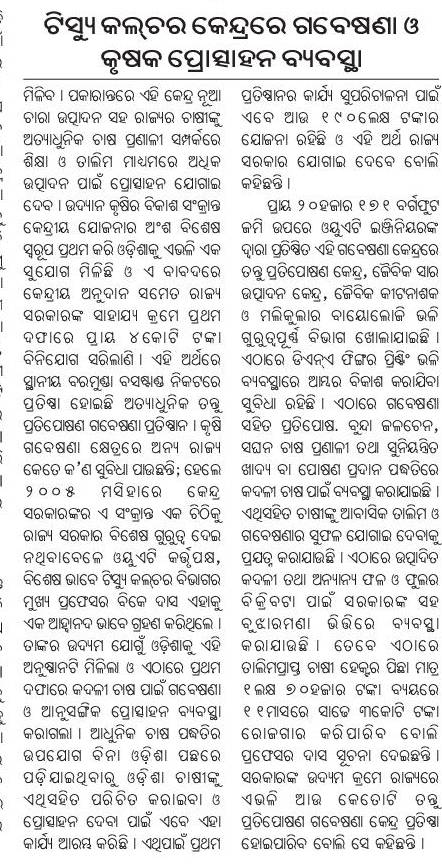Archive for January, 2009
Following is from a report in Pioneer.
Prof. Madhusudan Chakrabarti will be appointed as the chief of the IIT, Orissa. Prof Chakrabarti is currently working as Deputy Director in IIT, Kharagpur. He is a Professor in Metallurgical & Materials Engineering. He is also a Life Member of the Indian Institute of Metals and Materials Research Society of India.
The following excerpt from a report in Telegraph lists the directors of all the six new IITs.
Directors to six new IITs were also appointed at today’s meeting. U.B. Desai, an electrical engineer from IIT Bombay, will head IIT Hyderabad. M.K. Surappa, who teaches metallurgy at IIT Delhi, will be the director of IIT Roopnagar (Punjab). IIT Kanpur civil engineer Sudhir Jain will head the IIT in Gandhinagar. Anil Bhowmick, from IIT Kharagpur’s rubber technology centre, will be the director of IIT Patna. IIT Kharagpur deputy director Madhusudan Chakraborty will head IIT Bhubaneswar.
This Times of India report names the IIT Rajasthan director as Prem Kalra.
January 29th, 2009
Among the 28 central schools for Tibetans, one of them is in Chandragiri of Gajapati district, Orissa. Following is information about that school from this page.
CST Chandragiri is located in the Eastern Ghat region at the height of 1900 feet above sea level, about 250 kilometres away from Bhubaneswar, the capital city of the state of Orissa. The school was established in Phuntsokling Tibetan Settlement in the year 1965 with the blessing of His Holiness the Dalai Lama and managed by Central Tibetan Schools Administration, Delhi, an autonomous body under the Ministry of Human Resource Development, Govt. of India. The school was established to impart modern education and to preserve and promote the rich Tibetan cultural heritage to the children of Tibetan refugees settled in Orissa.
At present the school has two primary school branches, one at Lobersing Camp No. 3 and another at Mahendragarh Camp No. 5 each with a headmaster. The main secondary school at Chandragiri has classes from VI to X. The school has a total strength of 345 students including both the branch schools. Tibetan is the medium of instruction at the primary classes and English in middle and secondary classes. The school is affiliated to the Central Board of Secondary Education (CBSE), Delhi and follows textbooks published by the National Council of Educational Research and Training (NCERT) and CBSE. The total staff strength is 32, which includes 23 teaching staff. The academic performance of the school continues to show improvement and the result of Class X CBSE Board examination held in March 2004 was 92.31% as against 52.77% last year.
The school has good facilities viz. spacious playgrounds, multi-purpose halls, computer lab, senior & junior science labs, audio-visuals, resource centre, library, OHP, art and tailoring sections. The Settlement Officer and Parent-Teacher Association take active interest in the development of the school.
January 29th, 2009
(Thanks to Abi for the pointer.)
Following is excerpted from a report in India Today.
… The academic-turned prime minister chose to call them ‘World Class Universities’, sexing up the comeget-me factor. “These universities should focus on international standards of excellence and be rated among the top institutions in the world. They must become the launching pads for our entry into the knowledge economy,” Manmohan said at a function held to celebrate 150 years of the University of Mumbai in June 2007.
… The chances of missing the February deadline to pass the bill in the short session of Parliament are high and the Government is looking at the possibility of pushing it through an ordinance.
…The UGC is of the view that the universities should be run by the government and wants to underplay the role of private players and corporates.
The ministry on its part is ready to open it up to “creditable private organisations” and offer them public land. The Knowledge Commission has a different take.
“Since public finance is an integral constituent of universities worldwide, most of the new universities shall need significant initial financial support from the Government. Each university may be endowed with a substantial allocation of public land, in excess of its spatial requirements,” says Sam Pitroda, chairman, NKC.
The excess land can be a subsequent source of income generation, he says. Exceptions need to be made in existing income tax laws to encourage large endowments.
… The NKC in its letter to the UGC chairman has also suggested that the syllabi should be revised every year to keep up with the changes and current developments in various disciplines. “Departments that do not update their syllabi for two consecutive years shall be asked to provide justifications,” says the letter. Another contentious issue is that of fixing fees and granting autonomy to the proposed universities.
The commission had envisaged that these universities shall have the autonomy to set student fee levels and tap other sources for generating funds such as industry collaborations and overseas operations. The autonomy of fees and greater autonomy for each university is a strict no-no for both the ministry as well as the UGC. Prompted by incisive memos from the Prime Minister’s Office, which is attuned with the views of the NKC, the ministry is planning to prepare a bill with critical minimum provisions, thereby enabling autonomy and innovation without going through a parliamentary process at a later stage. Otherwise, it will have to resort to the ordinance route, bypassing Parliament.
… As a first step, the ministry has decided to do away with the tag of World Class University, an idea which has won it the NKC’s applause . The Act will now be termed the National Universities System Act instead of the World Class University System Act.
Hope the people who wonder about Vedanta University’s land requirement will get a better understanding of it from the NKC’s suggestion regarding providing excess land to the proposed National Universities.
January 26th, 2009
Following is from a report in Pioneer.
The Centre has approved a proposal to set up four polytechnics in Malkangiri, Boudh, Gajapati and Sambalpur districts of the State.
In order to lure the youth of the Maoist-predominant areas towards technical education the Union Ministry of Human Resource Development (MHRD) has chalked out a plan to establish more diploma engineering institutions. Orissa being largely affected by Leftwing extremism has been benefited handsomely. Malkangiri is the State’s worst Maoist-hit district.
While each polytechnic will be established at the cost of Rs 12 crore, the MHRD has provided Rs 8 crore as the first installment. Technical Education Director Vir Vikaram Yadav said the State Government is planning to establish polytechnics in all districts. The State now has 13 polytechnics, while there are seven such private institutions imparting diploma in engineering.
With the four new institutions planned, many other districts are still left out. The new districts carved out in the 1990s, Kendrapada, Jagatsinghpur, Bhadrak, Nayagarh, Nabarangpur and Subarnapur do not have any polytechnic.
Yadav said that the State Government also decided to cover all the blocks with Industrial Training Institutes (ITIs). Accordingly, plans are afoot to cover 125 blocks which are yet to have an ITI.
January 25th, 2009
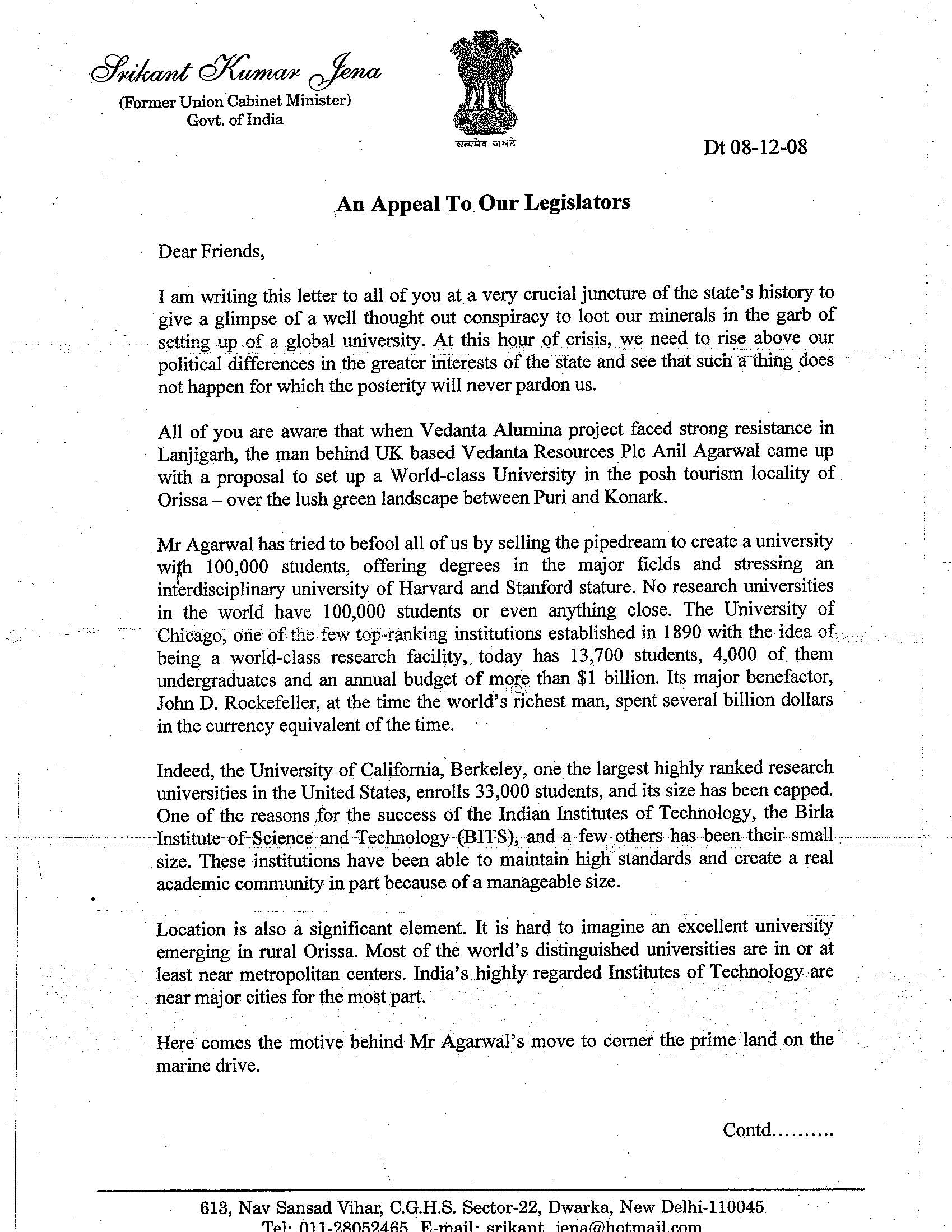
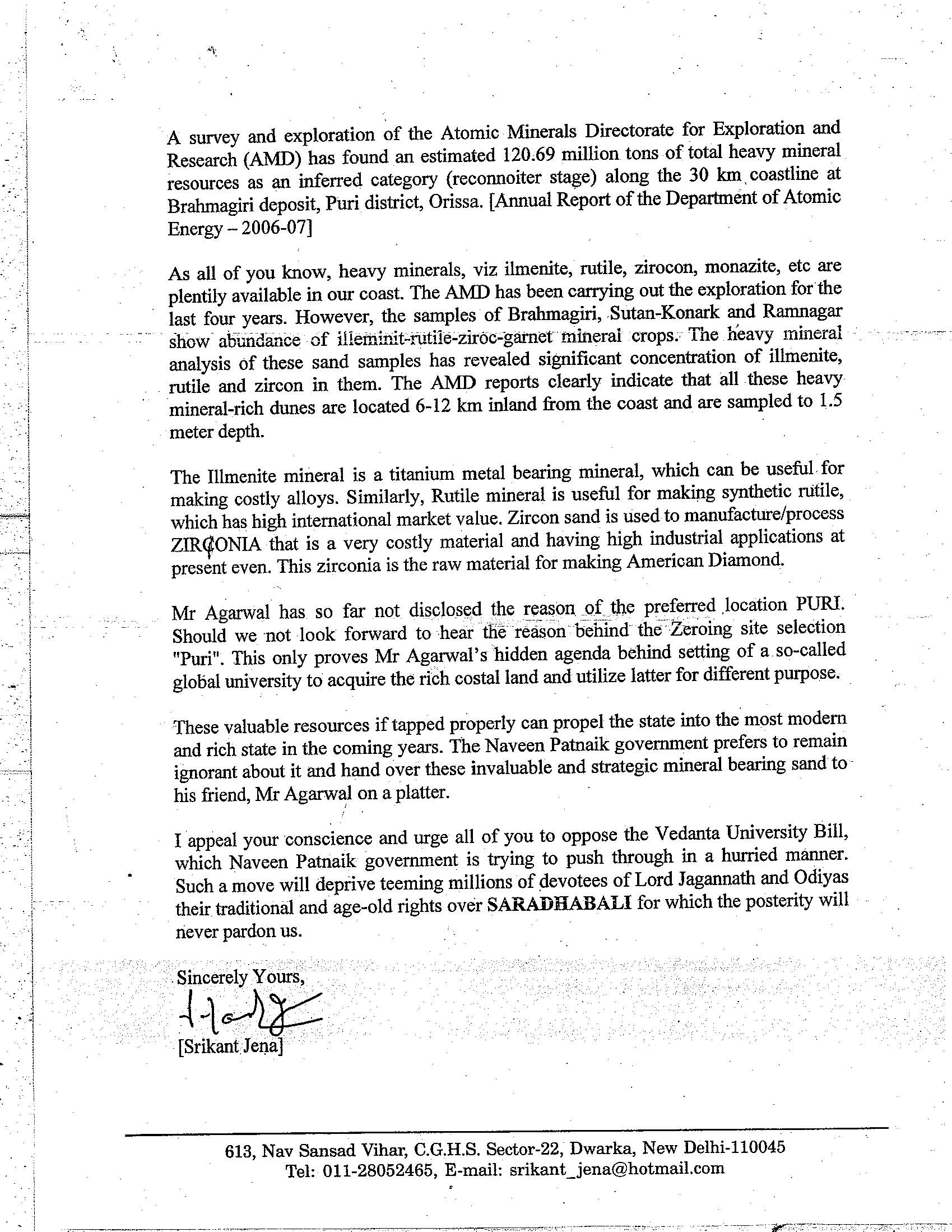
I would now like to rebut the couple of points mentioned in the above writing.
(i) In regards to the size it is true that no world class university currently has 100,000 students. However, several of them have around 50,000 students. Please see Q6 of https://www.orissalinks.com/archives/1696. Some of them, especially Arizona State University, expects to reach a size of 85,000 by 2030. Moreover, one must note that Vedanta University aims to have 100,000 students at build out, which may be in 20-25 years or beyond.
(ii) On the issue of minerals, one just has to make sure that it is explicitly mentioned that any mineral from that land becomes state property and have a mechanism to monitor it.
(iii) On why in a rural location; the Vedanta University location is about 40 kms from the outer edges (Jatni) of the Bhubaneswar area. With plans to connect it by a 4-lane highway it will only take 25-45 minutes to get there from various points in Bhubaneswar. Also, most the new IITs that are coming up, especially IITs in Hyderabad, Punjab, Patna and Indore, are 25-50 kms from the airports or city center of their respective metropolitan areas.
January 20th, 2009
Following is an excerpt from a report in Telegraph.
New Delhi, Jan. 16: President Pratibha Patil has promulgated an ordinance allowing the government to establish 15 new central universities despite last-minute objections by the National Knowledge Commission that the ordinance would hurt higher education.
The President signed the ordinance late last night even as the commission headed by Sam Pitroda tried to convince the Prime Minister and senior government officials against the move.
Patil’s signature triggered a chain of events today that saw the human resource development ministry launch a process of selection of vice-chancellors within hours.
It has also set off fireworks between the commission and the ministry, which the commission believes is keen to retain control over universities while officially calling them autonomous.
… The government is keen to start classes at the universities in the 2009 academic session, said the ministry note to the President.
The ministry, a top HRD official said, will bring the ordinance before both Houses when Parliament meets briefly in February. “We want the ordinance to be cleared by both Houses in the narrow slot for which the Parliament is meeting so that we can start classes from 2009,” the official said.
An ordinance needs parliamentary ratification within six months.
One of the above mentioned 15 universities will be in Orissa; Earlier the Orissa government recommended the Koraput area as the site of this university. As per the bill, available here, the one in Orissa will be called Central University of Orissa.
An earlier copy of the bill (before Goa University was taken out) is available here. There was last minute criticism of the bill and request to not promulgate it as an ordinance by the National Knowledge Commission. See news reports on this here and here. But the President promulgated the ordinance anyway.
January 18th, 2009
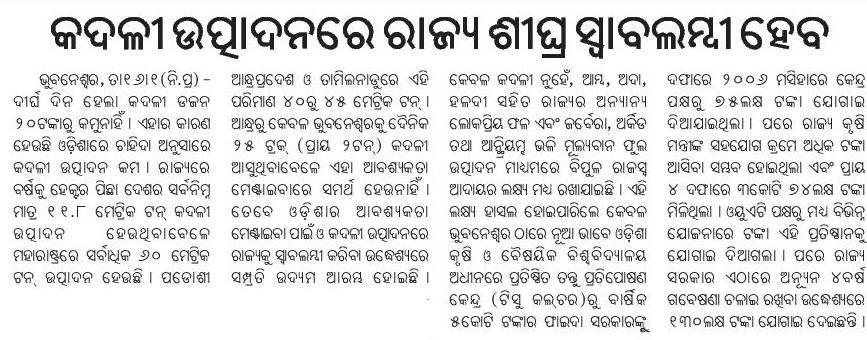
January 17th, 2009
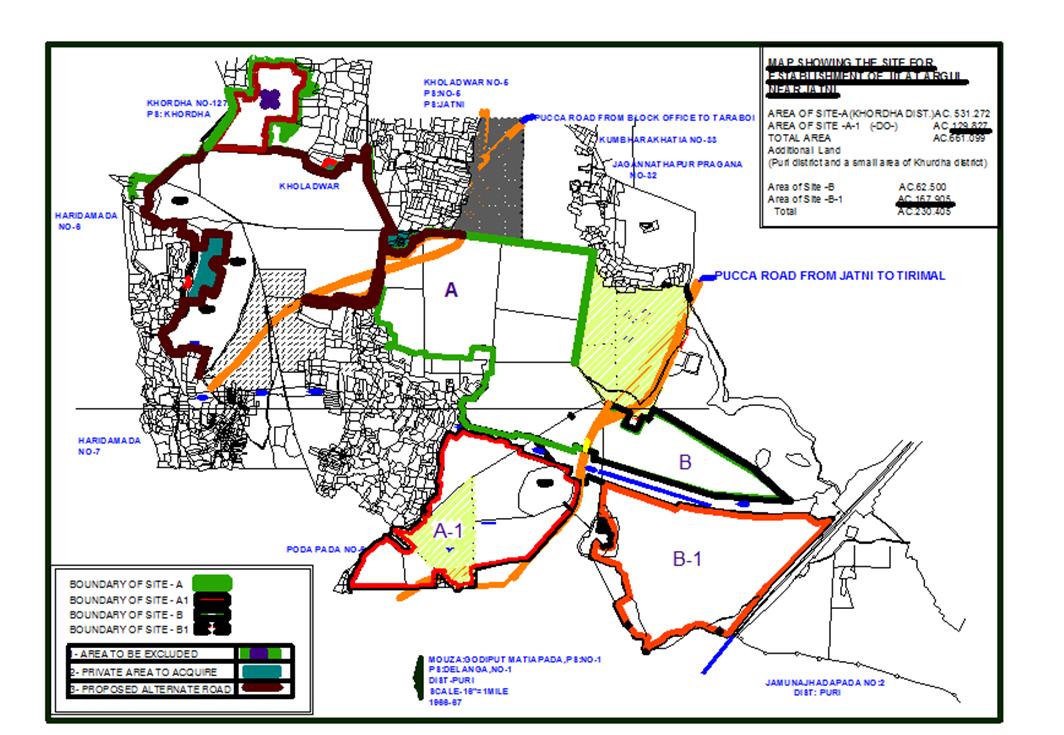
January 17th, 2009
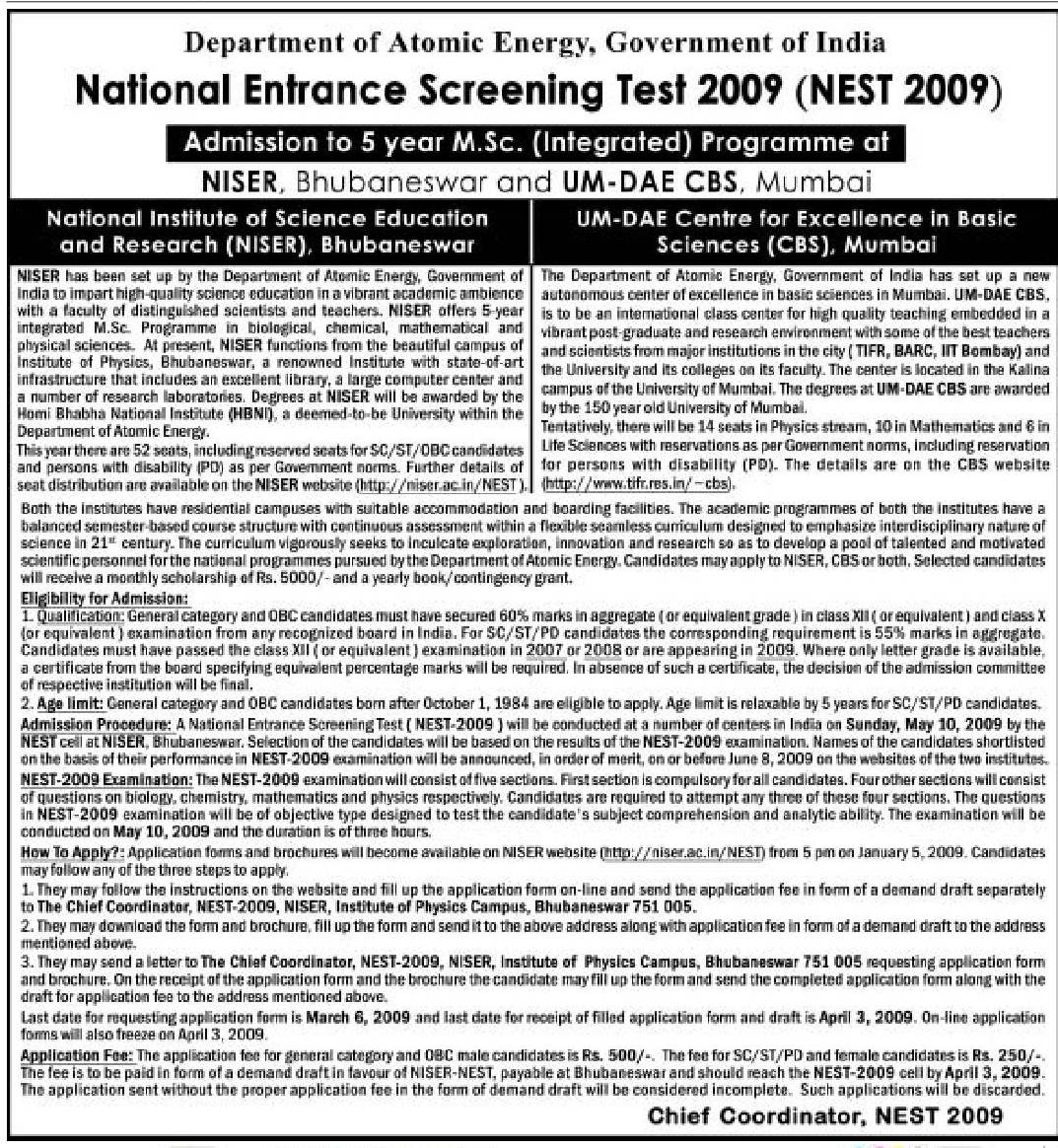
Unlike the IISERs that take students from the IIT exams and KVPY, NISER Bhubaneswar (an IISER-equivalent institute that is funded by DAE) teams up with UM-DAE and has its own exam called NEST. (They also took students from KVPY.)
The following information regarding NEST 2009 is from http://niser.ac.in/NEST/.
About NEST
National Entrance Screening Test (NEST) is a compulsory test for students seeking admission to National Institute of Science Education and Research (NISER), Bhubaneswar and University of Mumbai – Department of Atomic Energy Centre for Excellence in Basic Sciences (UM-DAE CBS), Mumbai. Both NISER and UM-DAE CBS have been started by Department of Atomic Energy, Government of India in 2007. Their mandate is to train scientific manpower for carrying out cutting edge scientific research and for providing input to scientific programs of Department of Atomic Energy and other applied science institutions in the country. The test is conducted in more than 25 centers across India. This brochure gives the detailed procedure for applying for the test, syllabus of the test and various dead lines.
NEST Brochure 
About NISER
NISER has been set up by the Department of Atomic Energy, Government of India to impart high-quality science education in a vibrant academic ambience with a faculty of distinguished scientists and teachers. NISER offers 5-year integrated M.Sc. programme in biological, chemical, mathematical and physical sciences. At present, NISER functions from the beautiful campus of
Institute of Physics, Bhubaneswar, a renowned Institute with state-of-art infrastructure that includes an excellent library, a large computer center and a number of research laboratories. Degrees at NISER will be awarded by the Homi Bhaba National Institute (HBNI), a deemed-to-be University within the department of Atomic energy.
This year there are 52 seats, including reserved seats for SC/ST/OBC candidates and persons with disability (PD) as per Government norms. Further details about the institute can be found on the NISER website (http://niser.ac.in).
NISER Brochure 
About UM-DAE CBS
The Department of Atomic Energy, Government of India has set up a new autonomous center of excellence in basic sciences in Mumbai. UM-DAE CBS, is to be an international class center for high quality teaching embedded in a vibrant post-graduate and research environment with some of the best teachers and scientists from major institutions in the city (TIFR, BARC, IIT Bombay) and the University and its colleges on its faculty. The center is located in the Kalina campus of the University of Mumbai. The degrees at UM-DAE CBS are awarded by the 150 year old University of Mumbai.Tentatively, there will be 14 seats in Physics stream, 10 in Mathematics and 6 in Life Sciences with reservations as per Government norms, including reservation for persons with disability (PD). The details are on the CBS website (http://www.tifr.res.in/~cbs).
Important Dates
- Last date for request of application form : March 6, 2009
- Last date for receipt of completed application form with DD : April 3, 2009
- Online applications freeze : April 3, 2009
- Dispatch of offline admit cards begins : April 15, 2009
- Download of online admit cards begins : April 15, 2009
- Date of examination : May 10, 2009 (Sunday), 1 pm to 4 pm
- Announcement of results on NEST website : June 8, 2009
Eligibility for appearing NEST
Students securing at least 60% marks in aggregate (or equivalent grade) in Class XII (or equivalent) examination from any recognized Board in India are eligible to apply. For Scheduled Cast (SC), Scheduled Tribes (ST) candidates and for Persons with Disability (PD), the minimum requirement is 55%. Students who have passed the Class XII qualifying examination in 2007 or 2008 or are appearing in 2009 are eligible to apply. (Where only Letter grade is given by the Board, a certificate from the Board specifying equivalent percentage marks will be required. In the absence of such a certificate the decision of the respective Admissions Committee will be final.)
How to apply (3 ways)
- Online form submission is the most convenient and preferred way. Follow these steps to go for it.
- Register yourself before you login.
- Confirm your registration from a mail sent to you just after registration.
- Login in the NEST homepage with your mail-id and password.
- Fill the form and save it or, modify an already saved form.
- Take the print-out and send along with DD.
- Form can be downloaded, filled and sent back with DD. Download form NEST Brochure Please set margin in the browser page-setup to accomodate the form in a single A4 sheet.
- A letter of request can be sent to get the printed form by post. This form will have to be sent back along with DD after filling it properly.
January 13th, 2009
Following is from the PTI report on this.
The government today approved an area of 935 acres near Jatni in Khurda district of Orissa as the site for the proposed IIT in the state.
"There were four possible sites for the top institute. But the government approved the location near Jatni as it has vast land area and is near to airport. The rail and road connectivity is very good to this place," a top HRD Ministry official told PTI here.
HRD Minister Arjun Singh will visit the state soon to lay the foundation stone for the elite technical institute, the official said.
He said the ministry had sent its site identification committee to the state on December 24 and 25 last year. The committee visited the sites near Jatni, Banki, Ramdaspur and Gayabandha.
"Among all the places, the committee found location near Jatni was the best from the point of view of future and growth prospects of the institute," he said.
… "The Centre also asked the state government to transfer the land to the IIT Society of IIT Bhubaneswar immediately so that the construction of the building and other facilities can be started," he said.
January 13th, 2009
Following is from http://pib.nic.in/release/release.asp?relid=46517.
Shri G K Vasan, Minister of State (Independent charge), Ministry of Statistics & Programme Implementation said that the Government of India has plans for setting up three new universities for the benefit of the children of NRIs and PIOs. While addressing at the Regional Session on Carribean at the 7th Pravasi Bharatiya Divas, 2009 today at Chennai, he informed that the first of these universities to be located at Bangalore is expected to be operational by the year 2010. These universities would have a reservation of 50 per cent seats for NRIs and PIOs. The Government has also increased the number of scholarships to 120 to facilitate unhindered access to higher education for children of NRIs and PIOs who are not economically well off in their adopted lands, the Minister added.
January 10th, 2009
Its web page is http://www.indianarmy.gov.in/aad/indexmain.html. Following are some excerpts from that page.
History:
The Army Air Defence College has an illustrious history dating back to pre independence era, when the School of Artillery was located at Quetta and the Anti Aircraft Wing was located at Karachi. When India gained Independence 1947, the School of Artillery and the Anti Aircraft Wing moved to Deolali. The Anti Aircraft Wing was renamed as the Air Defence Wing and was placed under School of Artillery.
In 1955 a case was taken up to relocate Air Defence Wing from Deolali, due to lack of adequate ranges for gun and missile firing. In 1963, the Government of Orissa offered 3000 acres of land at Gopalpur -On –Sea, along with seaward firing range, which was accepted in 1968. In 1979, Government of India sanctioned the establishment of Air Defence and Guided Missile School and Centre at Gopalpur – On – Sea. Gopalpur Cantonment was inaugurated on 30 October 1984 by late Shrimati Indira Gandhi, the Prime Minister of India.
January 9th, 2009
Following is an excerpt from a report in Indopia.
Domestic steel producer Jindal Steel and Power has invested about Rs 300 crore to set a law school as part of its O P Jindal Global University project and will also approach corporate houses like Tatas and Ambanis to pump in more funds in the form of endowments.
The college, envisioned by JSPL Executive Vice-Chairman and Managing Director Navin Jindal, has been at the university campus in Sonepat, Haryana. The first session of the college, is expected to start in September this year.
" Jindal Global Law School will be the first phase of our endevour to promote excellence in higher education by setting up O P Jindal Global University. We have infused up to Rs 300 crore at the moment and expect more investment in form of endowments and donations," O P Jindal Global University Professor and CEO C Raj Kumar told media.
…The law college would function in collaboration with the top institutes worldwide like Harvard Law School among others and would offer a three-year post-graduate LLB programme. The institute is also planning to commence a five-year undergraduate programme in law.
Kumar said school would have competitive fee structure of Rs six lakh per annum and would offer scholarship and easy loan schemes to them.
The Orissa government should push JSPL for setting up similar higher education institutions in Orissa where they have existing operations (such as an iron ore mine in Tensa, Keonjhar) and where they are expanding some operations. In particular:
January 9th, 2009
Silicon Institute of Technology, perhaps the best private engineering college under BPUT and among the top 5 engineering colleges under BPUT is making a campus in Sambalpur that is expected to start in 2009. It will be most likely called as: Silicon Institute of Technology, Sambalpur.
This campus will be located few kms away from Sambalpur on the Sambalpur-Jharsuguda highway.
This campus will have some of the the traditional branches, such as Civil Engineering, which are not there in the Bhubaneswar campus.
January 9th, 2009
Following is from http://pib.nic.in/release/release.asp?relid=46323.
The Cabinet Committee on Economic Affairs today gave its approval for a new Centrally sponsored Scheme by the name of National Mission on Education through Information and Communication Technology (ICT) submitted by the Ministry of HRD.
An amount of Rs.4612 crore is to be incurred during the 11th Five Year Plan for the National Mission on Education through ICT. There is a budget provision of Rs.502 crore during the current financial year 2008-09.
The National Mission on Education through ICT has been envisaged as a Centrally sponsored Scheme to leverage the potential of ICT, in providing high quality personalized and interactive knowledge modules over the internet/intranet for all the learners in Higher Education Institutions in any time any where mode. This is expected to be a major intervention in enhancing the Gross Enrolment Ratio (GER) in Higher Education by 5 percentage points during the XI Five year Plan period and in ensuring access and equity in Higher Education, as also recommended by the Oversight Committee and the National Knowledge Commission. The Mission has two major components viz., (a) content generation and (b) connectivity along with provision for access devices for institutions and learners. It seeks to bridge the digital divide, i.e. the gap in the skills to use computing devices for the purpose of teaching and learning among urban and rural teachers/learners in Higher Education domain and empower those, who have hitherto remained untouched by the digital revolution and have not been able to joint the mainstream of the knowledge economy. It plans to focus on appropriate pedagogy for e-learning, providing facility of performing experiments through virtual laboratories, on-line testing and certification, on-line availability of teachers to guide and mentor learners, utilization of available Education Satellite (EduSAT) and Direct to Home (DTH) platform, training and empowerment of teachers to effectively use the new method of teaching learning etc.
The Mission shall work in close cooperation and collaboration with other Missions/Schemes such as the National Translation Mission, Vocational Education Mission, National Knowledge Network, Scheme of ICT @ Schools etc., to avoid any duplication and attain synergy. It would operate through inter-departmental and multi-disciplinary approach. On the one hand, the Mission would create high quality e-content for the target groups and on the other, it would simultaneously extend computer infrastructure and connectivity to over 18000 colleges in the country including each of the departments of 419 universities/deemed universities and institutions of national importance on a single point rental basis through the Department of Telecommunications (DOT), in a manner that would permit their seamless interaction with a integrated National Knowledge Network. The advent of very low-cost-low-power consuming access cum computing devices, would further enhance the reach of the network. The peer group assisted content development would utilise the wikipaedia type of collaborative platform under the supervision of a content advisory committee responsible for vetting the content. Interactivity and problem solving approach would be addressed through “Talk to a Teacher” segment. The Mission would also have a component of Teacher Empowerment through proper training and digital literacy of teachers to be able to use the e-contents. Renowned institutions would anchor various activities in their areas of excellence. The Mission would seek to enhance the standards of education, in Government as well as in private colleges. Enlistment of support and cooperation of States/Union Territories, Institutions and individual experts would be an integral part of the Mission.
The Mission will ensure that there is no duplication with National Knowledge Network. It will also cater to contents for higher education sector. National Programme of Technology enhanced Learning (NPTEL) Phase II and III will be part of the generation activity.
The Mission would have a three tier committee system to monitor and guide its functioning. The apex National Committee would be chaired by Hon’ble Minister of Human Resource Development. It would decide on all policy and administrative issues and prescribe guidelines for the functioning of the two sets of Committees namely ‘Empowered Committee of Experts (henceforth shall be called as ‘Project Approval Board’) would be sanctioning individual projects and monitoring the overall progress through various peer reviews and concurrent evaluation.
Ministry of HRD, Deptt. of Higher Education would enter into MoU with State Governments for proper monitoring of the Scheme in their State and contribute 50% of the cost of hardware and 25% of the cost of connectivity in respect of the colleges/institutions/universities maintained or substantially funded by it. Similar MoU would also be entered into with Mentor institutions for private/self-financing colleges/institutions/universities for ensuring that the beneficiary institutions contribute 50% of the cost of hardware and 25% of the cost of connectivity and maintain and sustain the facility created under the Scheme after expire of 5 years.
The projected benefits/results of the Scheme would be enhancement of access to quality education, making available knowledge modules in cyber space and optimal utilization of available resources by using of ICT for educating the masses, especially those inhibited in remotely located areas and places at disadvantage.
*****
AD/SH/LV
January 3rd, 2009
Following is from http://pib.nic.in/release/release.asp?relid=46321.
The CCEA today approved the implementation of a centrally sponsored scheme to universalise access to and improve quality of education at Secondary stage, called Rashtriya Madhyamik Shiksha Abhiyan (RMSA) during the 11th Five Year Plan.
As regards the Financing pattern and fund flow, Union Government shall bear 75% of the project expenditure during the 11th Five Year Plan, with 25% of the cost to be borne by State Governments. Sharing pattern will be 50:50 for the 12th five year plan. For both the 11th and 12th Plans, funding pattern will be 90:10 for North Eastern States. Rs.20,120 crore has been allocated for the Scheme during the 11th Five Year Plan.
The objective of the Scheme is:
• to achieve a General Enrolment Ratio (GER) of 75% for classes IX-X within 5 years by providing a secondary school within a reasonable distance of every habitation;
• to improve quality of education imparted at secondary level through making all secondary schools conform to prescribed norms;
• to remove gender, socio-economic and disability barriers, Universal access to secondary level education by 2017, i.e. by the end of 12th Five Year Plan and Universal retention by 2020.
Broad physical targets include improving the enrolment ratio for classes IX-X to 75% within 5 years from 52.26% as in 2005-06, providing facilities for estimated additional enrolment of 32.20 lakh by 2011-12 through, strengthening of about 44,000 existing secondary schools, opening 11,188 new secondary schools, appointment of 1.79 lakh additional teachers and construction of 80,500 additional classrooms.
Interventions approved include providing infrastructure in schools such as new classrooms with furniture, library, science laboratory, computer room, disabled friendly provisions etc, recruitment of additional teachers with emphasis on Science, Mathematics and English teachers, in service training of teachers, teaching aids such as ICT and special focus on SC/ST/Minorities Girls. Steps such as priority for opening or upgradation of schools in areas of SC/ST/minority/weaker section concentration and enrolment drives and special coaching classes in those areas are also envisaged under the scheme.
The Scheme will be implemented in a Mission mode, with a National Mission headed by the Union Minister for HRD and a Project approval Board headed by Secretary (School Education and Literacy) to appraise and approve state plans. Similarly, State Missions under Chief Ministers of the States/UTs will be set up.
The Scheme envisages development of State-specific norms and District will be the unit of planning. The district plan will be appraised and consolidated at the State level and the State plan will be appraised by the technical support group attached to the National Mission. The civil construction will be through School Management and Development Committee with representation from parents, Panchayati Raj Institutions and civil society.
*****
AD/SH/LV
January 3rd, 2009
Previous Posts



